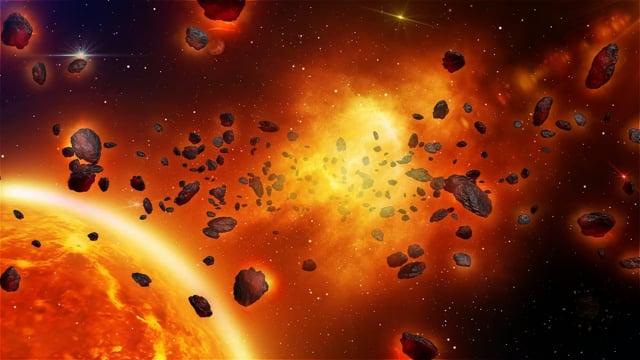The Real-Life Asteroid That Inspired a Sci-Fi Epic: Apophis and the Garnet Stars

“A 370-meter-wide asteroid, locked on a potential collision course with Earth.”
Fiction? No. It’s the true story of Apophis (99942)—an asteroid named after the Egyptian god of chaos that once sent shockwaves through the scientific community. As per NASA, it was projected to possibly strike Earth in 2029 and then again, possibly in 2036. NASA, tracking its every move, gave it a chilling probability: a 1-in-45,000 chance of impact. In cosmic terms? A whisper away from fate.
And yet, what if this isn’t just a sublime threat but a signal?
It is safe to say that the threat has been ‘somewhat’ addressed, but its story has just begun.
And in Jeanell P Holmes’s sweeping new sci-fi fantasy epic, Apophis and the Garnet Stars, is more than an asteroid. It’s a test, a myth, a ticking cosmic clock. Jeanell takes one of modern science’s most harrowing near-misses and transforms it into a sprawling saga that merges mythology, astrophysics, and emotional depth with quiet perfection.
Where Science Meets Story – The Keyhole Twist
Apophis’s threat hinges on a sliver of space known as the gravitational keyhole—a tiny region in Earth’s orbit. If it passes through this zone during its 2029 flyby, gravitational forces could nudge its path just enough to ensure a catastrophic collision seven years later, on April 13, 2036.
This scientific concept has been wisely turned into a tale in the Apophis and the Garnet Stars. Jeanell turns the keyhole into something not just confined to the definition of a celestial hazard but a metaphor for fate. In the novel, it represents Earth’s final opportunity to rewrite its future.
“The keyhole isn’t just a gap in space. In this story—it’s fate’s only window.”
In Jeanell’s timeline, Apophis strikes. A point where the concept of Apophis meets fiction.
Oceans rise. Ash rains. Civilization collapses. And the only hope is rooted in the past—specifically, the moment when the asteroid nearly hits.
The countdown resets. The race begins again.
Jeanell’s story brings the drama before the asteroid actually hits the world in reality.
A Cosmic ‘What If’
While all that the world could see was danger in Apophis, Jeanell saw an opportunity, a story—an indication of a true storyteller. In her universe, the stars don’t just shine; they choose. Humanity’s salvation lies not in missiles or science but in the Garnet Stars, six celestial beings who once shaped the cosmos but were scattered across Earth and stripped of their memories.
Marked with star-born tattoos and hidden across continents, the Garnet Stars are reawakened as the Earth trembles. Aurora, Novus, Celeste, Astra, Stellar, and Vega—each carries a unique cosmic power and personal arc, wrapped in mystery and myth.
Each must rediscover their identity and their purpose. Their bond is emotional. Their powers are poetic. And their enemy?
Not just Apophis.
But Nym, the Dark Mother—an ancient force of forgotten stars and broken dreams. Shaped by cosmic loneliness and left behind in the fourth dimension, Nym seeks not to destroy out of rage but to be remembered.
Reframing Apophis – From Rock to Revelation
In Apophis and the Garnet Stars, Apophis doesn’t just hit the planet—it becomes a symbol of everything Earth has ignored. It’s the villain and the messenger, a force shaped by both human neglect and ancient war.
Apophis, in Pete’s novel, becomes mythological—a serpent in the sky, a test sent by the cosmos itself.
To stop it, the Garnet Stars don’t fire lasers or build rockets. They manipulate Earth’s rotation, hoping to nudge the planet’s mass just enough to guide the asteroid through the keyhole in 2029, avoiding the 2036 impact altogether.
It’s a strategy that blends science fiction with speculative science, creating high-stakes drama grounded in real-world possibility.
Why This Matters
What makes Apophis and the Garnet Stars so gripping isn’t just the scale of its world. It’s also the emotional gravity it offers. It is a tale rich in themes of forgotten ancestry, cosmic purpose, and the power of rediscovered identity. The Garnet Stars’ journey is more than a fight against time—it’s a search for belonging and the rekindling of divine memory.
And at its heart is the real question: “What if Apophis doesn’t miss? And what if the only force powerful enough to stop it… was written in the stars all along?”
With characters as layered as constellations, enemies crafted from existential fear, and a plotline lined with concepts of quantum theory, prophecy, and love into a cosmic tapestry, Apophis and the Garnet Stars—coming soon to your favorite stores—is more than a novel. It’s a myth reborn through science.
As 2029 approaches, Apophis will return to our skies. But long before it arrives, Jeanell P Holmes invites readers to explore a version of its story where the sky doesn’t just fall—it calls.

Source: The Real-Life Asteroid That Inspired a Sci-Fi Epic: Apophis and the Garnet Stars



